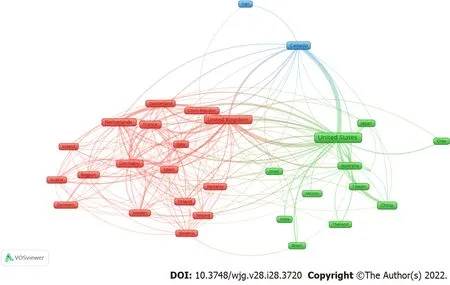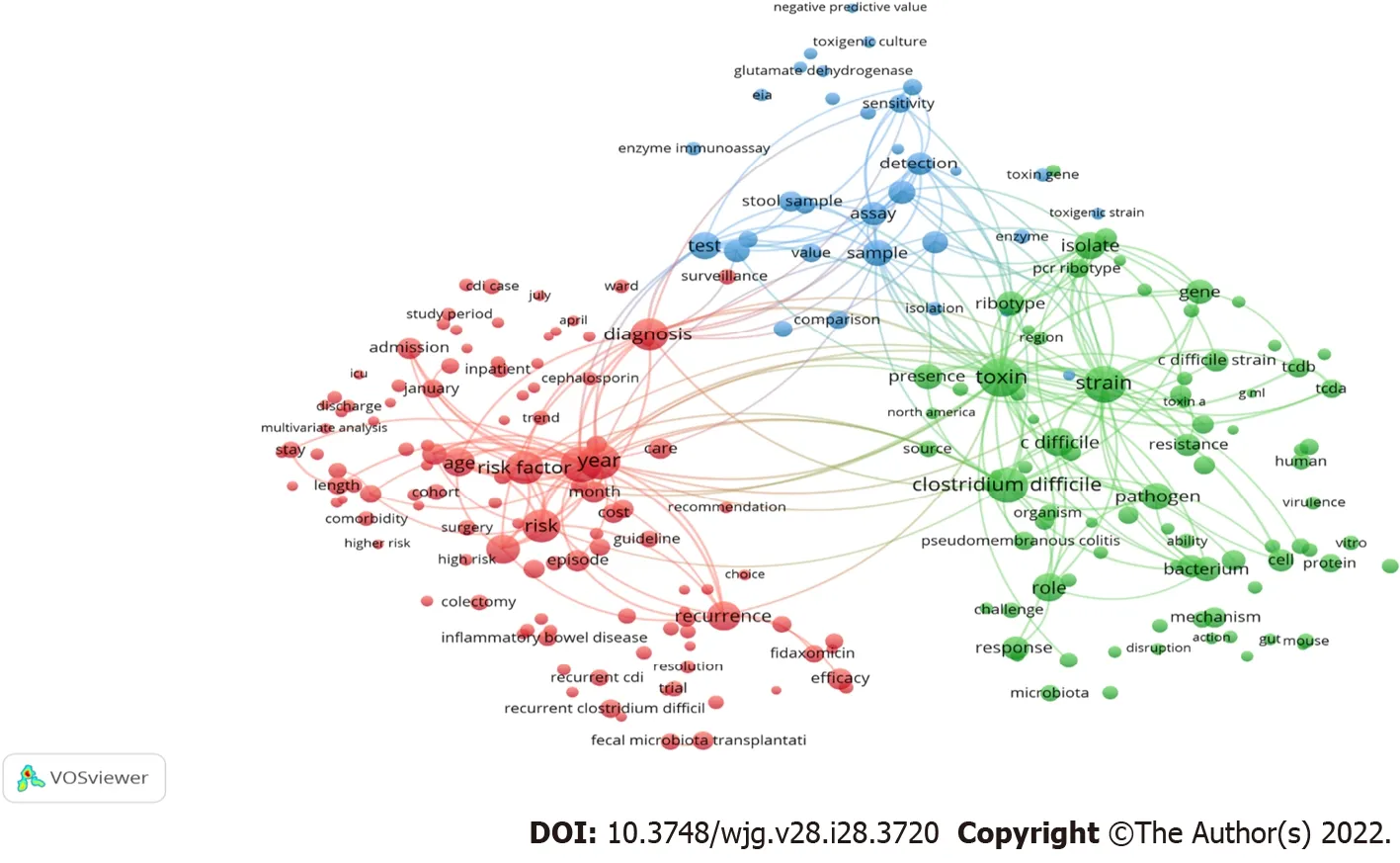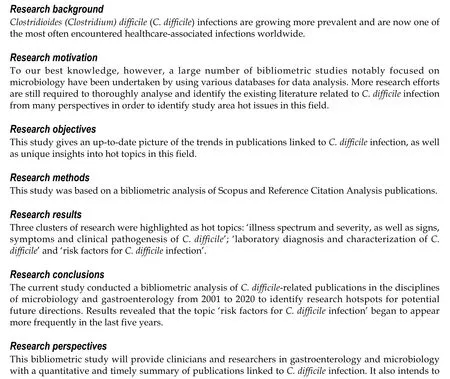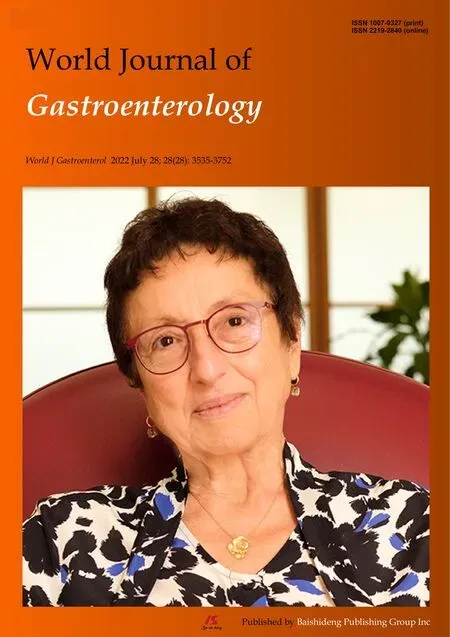Global research on Clostridium difficile-associated diarrhoea: A visualized study
Sa'ed H Zyoud
Abstract
Key Words: Clostridioides; Clostridium difficile; Bibliometric; Scopus; VOSviewer; Diarrhoea
INTRODUCTION
Clostridium difficile(C. difficile) has been reclassified asClostridioides difficile, although the preferred term remainsC. difficile.C. difficileinfections are increasing in prevalence and are among the most common healthcare-associated illnesses globally[1-3].C. difficileinfections, also known asC. difficile-associated diarrhoea, are the most common signs of clinical infection and can range from mild diarrhoea to fulminant colitis[4].C. difficileis frequently linked to the use of antibiotics.C. difficilewas once thought to be predominantly a nosocomial illness; however, community-acquiredC. difficilehas already been identified[3].
Metronidazole and vancomycin have been the primary treatments forC. difficileinfections for more than three decades. However, the low number of sustained cures and the rising incidence ofC. difficileinfections, as well as the accompanying morbidity and death, have necessitated the development and investigation of novel treatment approaches[1,5]. Despite ongoing attempts to enhanceC. difficileprevention and treatment,C. difficilecontinues to be a major public health concern. In both hospitals and the community,C. difficileinfection is still a prevalent and dangerous problem. In recent years, faecal microbial transplantation has been developed as a safe and successful method of treatment for recurrent infections[6-11]. Therefore, faecal microbial transplantation will most likely become the standard therapy for recurrent infection as a novel technique[6-11].
Bibliometrics and research performance assessments have been performed in a broad range of health areas[12,13], particularly to address environmental[14-17], and toxicological[18] issues. Yet, to our knowledge, a large number of bibliometric studies noticeably focused on microbiology[19-23] have been conducted by using different databases for data analysis. Because of these studies[19-23], microbiology research has recently been given increased scientific attention worldwide. Still, more research efforts are needed to thoroughly review and identify the existing literature related toC. difficileinfection from different aspects, including authorships, country, affiliation, journals, citation patterns, and content analysis, to determine the research areas that are hot-button issues in this field.
C. difficileinfection is considered one of the most debated topics in this era. Using the bibliometric approach toC. difficileinfection would affect how scientists design and conduct studies and the selection of models that estimate risk. Using a bibliometric analysis of publications in Scopus, this study provides an up-to-date picture of the trends in publications related toC. difficileinfection, together with specific insights into hot-button issues in this field. The significance of this study lies in the fact that, to our best knowledge, there are no previous bibliometric studies onC. difficileinfection research. Therefore, this study presents the evolution ofC. difficileinfection-related publications over time. This bibliometric study will provide clinicians and researchers in gastroenterology and microbiology with a quantitative and timely summary ofC. difficileinfection-related publications. Furthermore, it aims to provide clinicians and researchers with a resource for principles and current evidence. A detailed understanding of the historical trends in this field of research and its obstacles may help to establish a framework for future gastroenterology scholarship.
MATERIALS AND METHODS
Data acquisition
The research data were taken from the Scopus bibliographic database and Reference Citation Analysis(RCA) (https://www.referencecitationanalysis.com/). Scopus was chosen because it has a larger number of indexed journals than other databases (e.g.PubMed or Web of Science) and is completely inclusive of all journals in Medline[24-26]. Scopus is the most popular set of scientific publications used in bibliometric and scientometric studies, together with PubMed or Web of Science[27]. In addition,Scopus contains indexed journals in the health, social, physical and life sciences. This enhances the likelihood of retrieving as many relevant publications as is feasible. Baishideng Publishing Group Inc.owns RCA, which is an open transdisciplinary citation analysis database (Pleasanton, CA 94566, United States)[28].
Search strategy
To identify studies related toC. difficile-associated diarrhoea, we took the following steps.
Step 1: Data extraction was performed on July 25, 2021 and the results obtained within one day to avoid potential bias due to the regular updating of the database. The terms used in the search engines were applied in Title ((TITLE (Clostrid* difficile) OR TITLE(‘C. diff*’) OR TITLE(‘Cl. diff*’)))) AND Title/Abstract (TITLE-ABS(diarrh*) OR TITLE-ABS(Antibiotic) OR TITLE-ABS(infection) OR TITLEABS(AAD)). More precisely, in the results, the search strategy for research related toClostridium difficileterms was limited to the title only to eliminate false-negative results. Search terms with different suffixes were truncated using an asterisk (*). The keywords used were chosen because they are commonly used in the literature related toC. difficile-associated diarrhoea[3,29-31].
Step 2: The year 2021 was omitted because the database records for this year would not have been completed at the time of the search.
Step 3: All retrieved documents were reviewed and analysed with respect to the following different bibliometric indicators, as in previous bibliometric studies[13,32-34]: (1) The annual number of publications onC. difficile-associated diarrhoea indexed in Scopus and published from 2001 to 2020; (2) Prolific countries, journals, and authors in this field in relation to the number of publications; (3) Research collaboration among the most productive countries; (4) The most frequently cited publications. It is likely that certain articles were cited more frequently than others due to the considerable period that had passed since their publication. Therefore, a citation index was generated for each article to overcome the bias caused by the period that had passed since publication. The citation index is derived by dividing the average number of citations by the number of years since the article was first published;(5) Hot-button issues in this field; and (6) RCA was used to determine the impact indexperarticle for the top ten most-cited publications.
Step 4: A network visualization map based on the publications retrieved from the Scopus database was created using VOSviewer (version 1.6.16) software (www.vosviewer.com). The output results from VOSviewer are displayed in clusters. The existing connections between the bibliometric data can be clearly visualized to analyse collaboration between countries. Furthermore, it illustrated the terms widely used in the titles and abstracts of the publications collected, showing the hot research topics.
RESULTS
General description of the retrieved publications
A total of 8127 documents on ‘C. difficile-associated diarrhoea’ published between 2001 and 2020 were retrieved from the Scopus database. From these publications, articles (n= 6062) were the most often published documents, comprising 74.59% of the total, followed by reviews (n= 1016; 12.50%) and letters(n= 384; 4.72%).
The trend of global publications
As shown in Figure 1, there was a growing trend in the number of publications onC. difficile-associated diarrhoea in the Scopus database between 2001 and 2020. It is obvious that there was an increasing number of publications mostly during two periods: From 2006 to 2013 and from 2014 to 2020. Since 2006, the number of relevant articles grew significantly, which is notable. Papers published during the last seven years (2014 to 2020) accounted for 60.16% of the total publications. As a result of these findings, the number of yearly publications grew progressively from 2014 to 2020, showing that the amount of research output increased steadily over that period.
Contributions by country
Table 1 shows that the United States was the most prolific country, whose authors published the most documents (n= 3585), followed by the United Kingdom (n= 1013), Canada (n= 556), and Germany (n=434). The first 10 countries in Table 1 produced 89.84% of the documents published related toC. difficileassociated diarrhoea. Analysis of international collaboration was conducted on the downloaded data based on co-authorship relationships between countries (Figure 2).
Contributions by institution
The top 10 most productive institutes in terms of total papers are listed in Table 2. The major academic contributions mainly originated fromUniversity of Leeds(2.50%),Leiden University Medical Center(2.35%)andHarvard Medical School(2.25%).
Contributions by funding agency
Table 3 lists the top 10 global funding agencies that sponsored research output onC. difficile-associated diarrhoea. Among them, eight agencies were from the United States, and two were from the United Kingdom. TheNational Institutes of Healthranked first, supporting the highest number of studies at 884.TheU.S. Department of Health and Human Servicesranked second (n= 841), and theNational Institute of Allergy and Infectious Diseasesranked third (n= 539).
Most active journals
The 10 most prolific journals are presented in Table 4. The most productive journal wasInfection Control and Hospital Epidemiology(n= 304), followed byAnaerobe(n= 276),Clinical Infectious Diseases(n= 251)andJournal of Hospital Infection(n= 212). Thus, the first 10 journals in Table 4 produced 23.97% of the documents published related toC. difficile-associated diarrhoea.
Most cited documents
Table 5 presents the 10 most often cited articles published onC. difficile-associated diarrhoea[35-44].Furthermore, the ten most cited articles have an impact indexperarticle of 45.6 to 313.9 (Table 5).
Most frequent topics
We studied the distribution of co-occurrence terms using VOSviewer software (the minimum number of occurrences of a term in all publications is 100 times in titles and abstracts) to detect directions and topics inC. difficile-associated diarrhoea research and understand the growth of this discipline. The size of the circle or node of a term equals that particular term's number of occurrences. For example, in Figure 3, of the 84961 terms, 385 terms occurred at least 100 times, distributed in three clusters: Cluster 1, shown by green dots, includes those terms commonly found in studies related to clinical features ofC.difficile, including the illness spectrum and severity, as well as the signs, symptoms and clinical pathogenesis ofC. difficile. Cluster 2, shown by blue dots, includes those terms commonly found in laboratory diagnosis and characterization studies ofC. difficile. Cluster 3, indicated by red dots, includes terms commonly found in studies related to risk factors forC. difficileinfections. To investigate the changes in hotspots over time, a network visualization map of the most frequent terms in the titles/abstracts of the retrieved documents was generated using VOSviewer software, and the results revealed that the topic ‘risk factors forC. difficileinfection’ began to appear more frequently in the last five years (Figure 4).
DISCUSSION
The current study was a descriptive study on global research output of publications related toC. difficileinfection. It is important to examine the quantity and quality of research in this field, given the changing epidemiology ofC. difficilemorbidity and mortality, worldwide escalation of antibiotic resistance and limited alternative preventive strategies forC. difficileinfection. This bibliometric analysis will aid in revealing key milestones and progressions in this field, detecting current shortages and developing trends and directing the field's future research path. The current study showed a fourfold increase in publications in the last decade. These results reflect those of Balsellset al[45] and Ofosu[46], who alsostated that in recent years, there had been a growing understanding of the principle ofC. difficileinfection, the risk factors associatedwith C. difficileinfection, the pathogenesis and clinical manifestation,prevention, diagnosis andC. difficileinfection treatment, including new emerging therapies and faecal microbiota transplantation.

Table 1 Top 10 countries published Clostridium difficile-associated diarrhea between 2001 and 2020

Table 2 Ten most productive and influential institutions in Clostridium difficile-associated diarrhea between 2001 and 2020

Table 3 Top 10 related funding agencies in Clostridium difficile-associated diarrhea between 2001 and 2020

Table 4 Ten most productive and influential journals in Clostridium difficile-associated diarrhea between 2001 and 2020

Table 5 Ten most cited publications and authors between 2001 and 2020 in in Clostridium difficile-associated diarrhea
The United States was the leading country inC. difficileinfection-related publications, contributing about half of all Scopus publications in this field. This is presumably due to economic prosperity and population growth, and the large number of microbiology researchers[47,48]. The economic basis plays an essential part in supporting scientific research in the current study. The majority of the top 10 funding agencies were based in the United States. High-income countries have published mostC.difficileinfection-related publications, with limited input from low- and middle-income countries. An analysis of the countries that generated the mostC. difficileinfection-related publications indicates that countries with economic power indicators have the greatest say in this field. This finding broadly supports the work of other studies in different areas linking scientific research output with geographical location and financial growth[12,49,50]. Various bibliometric analysis studies have also shown that the United States is the most prolific country in microbiology research output[19,20,23,51].

Figure 1 Annual number of publications on Clostridium difficile-associated diarrhea indexed in Scopus and published from 2001 to 2020.

Figure 2 Network visualization map of country co-authorships. Of the 103 countries, 31 had at least 50 publications.
The current study showed that the most frequently cited article onC. difficile-associated diarrhoea,written by Cohenet al[35] and published in 2010, with 2370 citations, is a guideline that updates the recommendations for epidemiology, diagnostics, therapeutics, infection control, and environmental management. The second most frequently cited paper has 2140 citations and addresses the effect of duodenal infusion of donor faeces in patients with recurrentC. difficileinfection; this article, published in 2013, was written by van Noodet al[42]. These two papers receive approximately 237 and 305.7 citationsperyear on average, respectively. However, the article with the second-highest number of citationsperyear, placed fourth in the ranking, was published in 2015 and was written by Lessaet al[44]. This paper aimed to produce more accurate national estimates the burden of illness, incidence,recurrence and death by collecting data from a variety of health care delivery and community contexts.Note that five papers published after 2010 appear in the top 10 most cited publications between 2001 and 2020 inC. difficile-associated diarrhoea.
Although it is challenging to reveal the quality or impact of publications through bibliometric analysis, to some degree, citations are considered an indirect measure of an article's contribution to the knowledge generated in the field,i.e.the connection between the research finding and its significance for science[52,53]. However, these analyses of the top 10 most cited publications will guide microbiologists interested in further studies by updating knowledge of current developments inC. difficileinfection-related publications and potential future directions for study.

Figure 3 Network visualization map of the most frequent terms in the titles/abstracts of the retrieved documents. Of the 84961 terms, 385 had at least 100 publications. Terms with the same color represent a separate cluster (research theme).

Figure 4 Overlay network visualization map of the most frequent terms in the titles/abstracts of the retrieved documents. The colors on the map reflected the period of emergence in the literature, with yellow representing terms that were relatively recent in the literature.
Analysis of the frequencies of occurrence of terms in publications can offer insights into certain fields'main and hot topics[54]. The current study found that highly cited literature focused on the signs,symptoms and clinical pathogenesis ofC. difficileconcepts and risk factors forC. difficileinfections. A clear theme to emerge from the results is that the most frequently cited publications onC. difficileinfections highlighted a range of subtopics similar to the hot research topics. A recent bibliometric study[55] was defined to assess global research activity on antimicrobial stewardship as one measure for efforts dedicated to containing antimicrobial resistance. This study found thatC. difficilewas frequently encountered as author keywords in the retrieved literature on antimicrobial stewardship. The United States Centers for Disease Control and Prevention has consideredC. difficileinfection an urgent danger in its 2019 Antibiotic Resistance Threats Report[56]. In a European point prevalence study,C. difficilewas rated sixth among bacteria responsible for healthcare-associated illnesses[57]. The majority ofC.difficileinfections in the United States are considered hospital acquired[58].
Strengths and limitations
This study offered the first bibliometric analysis ofC. difficileinfections from the unique perspective of its research hotspots to determine the influential scientific areas and global trends.C. difficileinfectionbased publications in microbiology were collected in the online Scopus database and analysed comprehensively, thoroughly and objectively. As with all previous bibliometric studies[13,31,32,59], the current study has some limitations. First, we preferentially selected English articles from the database but lost some articles that were not in English. Second, we chose Scopus alone as the data source forC. difficileinfection research because it presented the most reliable and credible information. Inevitably, any useful information from other medical sources such as PubMed and Web of Science would be overlooked. On the other hand, Scopus remains the best database available for analysing research activity and identifying research hotspots on a certain topic. Given these limitations, we believe that this study offers a qualified global view ofC. difficileinfection-based publications in the field of microbiology from 2001 to 2020.
CONCLUSION
The current study used a bibliometric analysis ofC. difficileinfection-based publications in the fields of microbiology and gastroenterology during the period 2001–2020 to determine research hotspots for possible future directions. The results showed thatC. difficile-based publications have grown rapidly since 2006. Research activity onC. difficileinfections has been an emerging topic during the last two decades and has been developed predominantly by scientists from the United States of America, the United Kingdom, Canada, Germany, France and China. Risk factors forC. difficileinfection, laboratory diagnosis and characterization ofC. difficile, signs, symptoms and clinical pathogenesis ofC. difficileconcepts were the main research hotspots inC. difficileinfection, and related studies should pioneer these fields in the future. Promising research avenues in the near future may draw the attention of relevant scientists and funding organizations and open up novelC. difficileinfection–based diagnosis and treatment approaches.
ARTICLE HIGHLIGHTS

be a resource for clinicians and researchers on principles and current evidence.
FOOTNOTES
Author contributions:Zyoud S developed the concept for the manuscript, reviewed the literature, formulated research questions, collected the data, conducted analyses and interpreted the data, and wrote the manuscript, the author read and approved the final manuscript.
Conflict-of-interest statement:All the authors report no relevant conflicts of interest for this article.
PRISMA 2009 Checklist statement:The author has read the PRISMA 2009 Checklist, and the manuscript was prepared and revised according to the PRISMA 2009 Checklist.
Open-Access:This article is an open-access article that was selected by an in-house editor and fully peer-reviewed by external reviewers. It is distributed in accordance with the Creative Commons Attribution NonCommercial (CC BYNC 4.0) license, which permits others to distribute, remix, adapt, build upon this work non-commercially, and license their derivative works on different terms, provided the original work is properly cited and the use is noncommercial. See: https://creativecommons.org/Licenses/by-nc/4.0/
Country/Territory of origin:Palestine
ORCID number:Sa'ed H Zyoud 0000-0002-7369-2058.
S-Editor:Fan JR
L-Editor:A
P-Editor:Fan JR
 World Journal of Gastroenterology2022年28期
World Journal of Gastroenterology2022年28期
- World Journal of Gastroenterology的其它文章
- Peroxisome proliferator-activated receptor gamma as a therapeutic target for hepatocellular carcinoma:Experimental and clinical scenarios
- Gut microbiota alteration and modulation in hepatitis B virus-related fibrosis and complications:Molecular mechanisms and therapeutic inventions
- Combination approaches in hepatocellular carcinoma: How systemic treatment can benefit candidates to locoregional modalities
- Update on endoscopic ultrasound-guided liver biopsy
- Non-alcoholic fatty liver disease-related hepatocellular carcinoma: Is there a role for immunotherapy?
- Potassium-competitive acid blockers and gastroesophageal reflux disease
